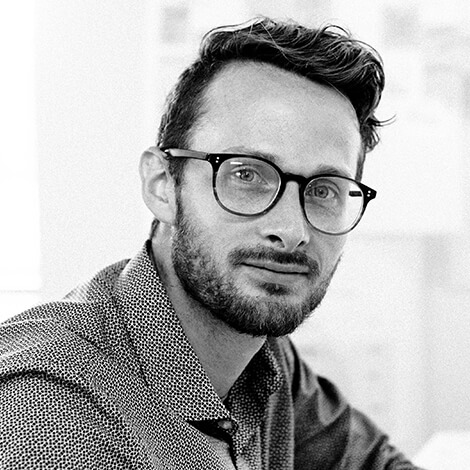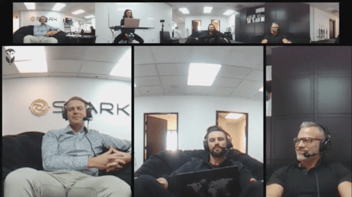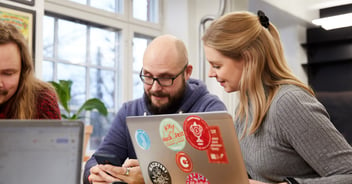This blog post will give a recap of the event by discussing:
- The moment we are in as Vincit but also as a species
- Two key challenges that we need to overcome
- Desirable Futures & Sustainable Digitalisation
- The Bigger Impact Workshop Outcome
The Moment We Are In
We kicked off the event with a quick introduction from our previous head of sales Jarkko Järvenpää, who spoke about Vincit’s journey and the inception of Planet Centric Design. Although Vincit is well-known for the positive impact we’ve had on working culture, our offering hasn’t been focused on the impact on the environment. With environmental challenges like climate change becoming such a burning issue, we felt the need to develop a new vision for Vincit. So we set out to create A World Without Fear for Tomorrow. For us, this means tackling sustainability challenges alongside our clients.
Just a week before the launch, the United Nations released a report on the gap between the amount of fossil fuels we currently burn and the reductions needed to limit global warming to 1.5 C or 2 C. We’re not even remotely close. What this tells us is that one way or another, the moment we are in as a species is an age of transition. Given the radical change we have caused to natural systems, like the rise in CO2 levels not seen for 3 million years, we will also continue to see radical changes to our social systems.
Planet Centric Design is a Process
We’ve pushed our planet to a breaking point. Be it through planned and strategic choices or collapse and breakdown, we believe that governments, companies, and consumers will increasingly face ever-more difficult choices. And our passionate guests agreed with us: as a society, we need to make radical changes to the way we work.
We built Planet Centric Design as a process to help any organisation tackle complex environmental issues. The new methodology and toolkit help organisations integrate nature, society and technology in a way that reduces resource use and emissions while enabling more sustainable lifestyles.
What are the key challenges?
At the launch event, we discussed two key challenges to doing this kind of work: navigating the complexity of these large-scale issues and the fact that we’re constrained by the logic of today, desperately in need different thinking to tackle the challenges of tomorrow.
How to Navigate Complexity
To grasp the complexity of sustainability challenges, we need to understand large-scale systems, the interdependent details and the numerous actors involved. The solutions to systemic problems require a model for collaboration that few know how to navigate. To make sense of this and to enable the radical collaboration needed for solving systemic issues, Planet Centric Design uses a methodology with new co-creation tools.
We need Different Thinking
As we discussed at the event, the logic of today has been built on the human-centred model of viability, feasibility and desirability. But these principles for design and development do nothing to consider the impact on natural systems.
A Wider Lens for Design
That is why Planet Centric Design introduces a wider lens into project work. This wider lens is responsible, systemic and transparent. It enables designers and companies to use thinking that can problematize the way society is currently functioning – and we clearly have a lot to improve in regard to sustainability. It helps us to spot the snags and ask the right questions, but it also allows us to come up with creative and innovative ways to turn problems into opportunities that make a positive change.
Desirable Futures & Sustainable Digitalisation
After covering the challenges, the new principles for design and the methodology for projects, we wanted to paint a more concrete picture of the projects we think can maximise positive impact and accelerate the sustainability transition.
To introduce these projects, we started by asking our guests: How easy it is to imagine a world without fear for tomorrow? People were a little baffled by the question and rightly so. So instead, we asked: How easy is it to imagine a world with a lot of fear for the future?
As you might expect, that world was a lot easier to envision. This is where we shoot ourselves in the foot. If we can’t imagine a world without fear for tomorrow, we’re never going to get there. We need to make a concerted effort and rewire our minds and the minds of organisations so that imagining desirable futures becomes easier.
Let’s create Desirable Futures together
That is why we believe that one of the most effective ways to use our new methodology with a wider lens for design is on a strategic level, helping our clients understand the implications of an age of transition. Radical change to the natural environment means radical changes to society and business.
Sustainability is a strategic must-win battle, and in this race, Planet Centric Design is your weapon of choice. With the co-creation methods of the Planet Centric Design toolkit, Planet Centric Designers help your organisation to define your role in the sustainability transition.
The Key Activities for Desirable Futures Projects
Projects will naturally differ depending on the maturity of the organisations, but one of the key outcomes is always a new vision for a sustainable future. A vision that steers your organisation toward desirable futures like a lighthouse in the storm. Designers work with you to uncover the barriers to attaining success and strategic pathways to overcome them. At the same time, new service and product ideas are created to develop innovative concepts that can reduce emissions and resource use while enabling sustainable lifestyles for society.
Through all this, Planet Centric Designers manage the interaction among a wide group of stakeholders and identify the right time to bring in external experts with new competence and insight needed to tackle complex environmental challenges. Of course, the future is always uncertain and understanding the impact of new strategies, products and services means managing change over time. Planet Centric Designers are responsible for helping organisations to stay on their course. They asses if the new strategies are having anticipated effects and, when necessary, they find ways for their clients to readjust.
But for any strategy to be successful, it will also need to integrate with operations and service delivery. This is where Sustainable Digitalisation comes in.
If it’s not Sustainable Digitalisation, then what is it?
A crucial point we emphasised at the launch event is that digital has touched the lives of nearly everyone from all corners of the planet. Although digitalisation has been packed with problems and is often used to exploit natural resources, it is a critical leverage point for positive change precisely because it is already so widespread and because it has so much room for improvement.
Sustainable Digitalisation means using our wider lens for design to create digital services that integrate data, people and natural resources in new ways, measurably reducing waste and emissions while enabling sustainable lifestyles. It means using technology like artificial intelligence and IoT to measure resource use and target areas of waste, helping organisations better understand the impact of their value chain. It means using service design to create transparent, informative services for users that bring their own personal “value chains” to the forefront.
But this doesn’t mean adding a button to a digital service to make it “green.” Enabling sustainable lifestyles through transparent digital services means bringing totally new offers to the market.
The Key Activities for Sustainable Digitalisation Projects
To make this happen, the Planet Centric Designer’s role is to do operational analysis using technology, like artificial intelligence and IoT, for data-driven decision-making. We’ll also need to map the relationships and interactions within our client’s networks to understand what the dynamics are and discover impactful levers for sustainable change. As we work to develop new services to deliver through a digital interface, we need to understand user behaviour and what incentivises users to choose the planet-centric options. Sustainable Digitalisation also means that we do green coding by reducing the amount of energy needed to run the service and by hosting the digital services in locations that use renewable energy.
Our collective workshop learnings
Finally, after the presentations, we divided the group into small teams and dove into the Bigger Impact canvas in the Planet Centric Design toolkit. The purpose of this tool and the three questions it proposes is to openly and honestly discuss some of our biggest worries, illuminate positive new movements addressing those concerns, and approach ways of participating in those movements.
The reflections of each team were then brought together to identify the most relevant themes. Here is a summary of our observations.
1. What do you think are the biggest issues facing humanity?
The themes that came up most often were immigration crisis, poverty, inequality, lack of food and water security, and loss of biodiversity. Also, our western lifestyle was mentioned, as well as individuals being blocked by fear, lacking a view of the big picture and being in silos.
2. What do you think are the movements working to solve those issues?
New legislation, youth activism, a change in consumer choices, and the rise of veganism were stood out. Impact-driven organisations, responsible investing and new business approaches, such as different metrics to measure success also came up.
3. How do you fit into those movements?
On a personal level, individual behaviour change, such as veganism, was often mentioned together with inspiring others to change, having conversations with other people to understand their views, dismantling silos, and breaking assumptions of the state of the planet by researching scientific facts.
On the professional level, it was surprising to see how many people have acknowledged the impact of their work in injecting new ideas or changing mindsets, whether internally in their organisations or externally with clients. It was interesting how some people found themselves in the facilitator role, breaking silos between different perspectives and areas of expertise.
Change is driven by two mighty and mundane movements
New technologies, such as new developments in alternative energy supply, were mentioned as a movement to drive change. However, they did not come up in the context of our individual actions. This suggests that imagining more sustainable ways of using technology in our personal or professional lives is a toughie. Considering how our daily lives revolve around technology, it is necessary for us to reflect our current behaviour patterns and find sustainable opportunities for applying technology.
In the answers to the first two questions, the media was repeatedly mentioned as one of the biggest issues and a movement for solving these issues. It was said to have both positive and negative impacts on political changes and citizens’ views on the environmental crisis. However, the ways in which we act on the negative impacts of media did not get mentioned. There’s food for further thought here: How can we be more critical of the media's role in the sustainability transition?
Conclusion
We were stoked to see everyone bring unique views to the discussions and to uncover the issues we as a society currently focus our actions towards and the ones we do not yet have an answer to. In this short amount of time alone, we were able to create a collective view and spark new thoughts for reflection that hopefully will fuel the different thinking that we all need to practice.
Are you ready to be Planet Centric?
If you are interested in discussing your organisation’s sustainability challenges and learning how Planet Centric Design can help you, we should meet up.



